Have you ever considered growing cabbage in your garden? There are dozens of ways to enjoy cabbage from soups to salads; stuffed cabbage rolls to fish tacos.
If you enjoy growing cabbage, you might also want to add lettuce to your garden too.
Contributed by Jodi Torpey, author and Master Gardener.

All about cabbage
People have been cultivating cabbage for at least four thousand years, making it one of the oldest vegetables around. Before planting cabbage on their own, they learned to harvest the wild cabbages that grew along the coastlines of western Europe.
Cabbage (Brassica oleracea) has long been valued for its healthful benefits that are now backed by scientific research. Each valuable head is loaded with beta carotene, vitamins C and K and plenty of fiber. There are dozens of ways to enjoy cabbage from soups to salads; stuffed cabbage rolls to fish tacos. [Go here for more brassica vegetables to try!]
Cabbage is a cool-season vegetable that needs to be planted at the right time, either early or late in the season. Cabbage can handle a light frost, but plants can bolt or start to go to seed if there’s an extended cold spell of several weeks or more.
Grow Some Greens!
Ready to grow fresh greens, no matter WHERE you live? Sign up for my
FREE quick-start guide and start growing some of your own food!
Watch weather forecasts carefully and plan to set out transplants 2 to 3 weeks before the last expected frost date for your region. Another good way to determine planting time is when soil temperatures reach 60 degrees.
Cool cabbage varieties for your garden
Many cabbage varieties are available for planting, depending on the color, size, number of days to maturity and how you plan to use the finished heads. Here are six favorites to get you started:
Overture is a hybrid cabbage from Burpee Seeds. This variety is known for producing large heads of sweet-tasting cabbage with a mild flavor; 85 days.
Katarina is an early-season cabbage, that produces 4-inch heads that mature quickly. An All-America Selections winner, Katarina has excellent eating quality; 45 days.
Ruby Ball Improved is a red-leaved cabbage that produces heavy and sweet round heads. This mid-season cabbage holds well in the garden and for storing, too; 78 days.
Late Flat Dutch is a tasty, large green-leaved cabbage that makes a good late season variety because it stores well. Heads grow up to 12 inches round and can weigh 15 pounds; 100 days.
Ruby Perfection is another red-leaved cabbage of medium size with dense and uniform-shaped heads. Thrips resistant, it makes for a good late summer or fall harvest; 85 days.
Gonzales is a sweet tasty mini-cabbage that’s perfect for small-space vegetable gardens. Each 6-inch green head is perfect for two servings; 55 days.
How to plant cabbage
If you want to start cabbage plants from seed, allow about 6 weeks of indoor growing time to get them to the best transplant size. Otherwise purchase transplants from a garden center and gradually acclimate plants to outdoor conditions before planting in the garden.
Cabbage transplants are good-to-go in the garden when there are five or six leaves on each plant. Space 18 to 24 inches between plants so they’ll have room to spread out and grow into nice-sized heads.
Set transplants so the lowest leaves are at ground level. Water well after transplanting and keep soil consistently moist. Water at soil level only and avoid getting the leaves wet to prevent foliar problems.
Be sure to add a layer of organic mulch, like straw, to keep weeds down and eliminate the need for hoeing between rows that can cause damage to plant roots.
Requirements for growing cabbage
Light requirements
Cabbage plants need sunshine, so find a good-sized garden spot that gets at least 6 hours of sun a day. Avoid planting cabbage where cabbage or any of its brassica relatives (cauliflower, broccoli and Brussels sprouts) grew in the previous two or three seasons. Rotating crops prevents common cabbage plant diseases and soil issues.
Soil requirements
Cabbage is a vegetable plant that likes a fertile soil. Amend the garden bed with plenty of organic matter, like high-quality compost, before planting. It’s also helpful to broadcast a 5-10-10 fertilizer over the garden before digging planting holes.
Water and fertilizer requirements
Cabbage plants need consistent watering so set up a drip irrigation system or soaker hose. Always water at the soil level.
Water well after transplanting and keep soil moist while plants are actively growing. Avoid letting the soil dry out completely.
Several weeks after planting, when cabbage plants are about 5 inches tall, side-dress plants with a rich compost or complete fertilizer (5-10-10). Maintain fertilizing through the season, especially when the heads begin to form. Stop fertilizing when cabbages begin to mature to avoid giving them too much nitrogen.
Controlling cabbage pests and plant diseases
Insect pests can ruin a cabbage crop in no time, so think ahead to prevent the two most common problems, cabbage root flies and cabbageworm butterflies.
Here are three recommended approaches:
Place cabbage collars on the soil around plant stems to prevent cabbage root flies from laying eggs on the soil near stems. Cabbage collars can be as simple as a 6–8-inch circle of cardboard with a slit cut to the center. Poke a hole in the center and fit the collar around each stem.
Cover young plants with row cover cloth to prevent cabbageworm butterflies from laying eggs.
Apply Bacillus thuringiensis (Bt) as soon as you see small white moths flying near plants. The easiest way to apply Bt is by shaking the dust over plants. Reapply after a rain or once a week until it’s no longer needed. Always follow label instructions.
Growing cabbage plants in containers
Small-space gardeners can try their hand at growing cabbages in containers. Select a 5-gallon or larger container, such as a half-whiskey barrel. Fill with a good quality potting soil meant for container gardening and avoid ordinary garden soil that’s too dense.
Add a slow-release fertilizer to the potting soil and mix in well.
Place the container in a full-sun location and plant the cabbage so the lowest leaves are at ground level. Water well, place a cabbage collar around the stem and spread a layer of organic mulch on the top of the soil around the plant.
Row cover cloth placed over each plant, and tucked in tightly around the edges, will help prevent insect pests.
Keep soil moist and don’t let it dry out completely.
How to harvest heads of cabbage
Cabbage heads often look ready to harvest before they’re fully formed. Test the cabbage by squeezing the heads to make sure each feels solid. If the inner leaves feel loose, let it continue to grow, using the squeeze test every few days.
Over-ripe cabbage is just as bad as under ripe. Heads can split if left in the garden too long or if the temperatures get too hot.
Be sure to make a clean cut with a sharp knife at the base of the plant when the cabbage is ripe. Leave a few of the outer leaves on the heads to help with longer storage.
Using cabbage in the kitchen
What can’t cabbage do? Use raw in slaws, sauté as a side dish, add to stir fry recipes or roast wedges in a high-heat oven or on the grill. Cabbage makes delicious soups, the leaves are handy wraps and steamed cabbage rolls are a culinary delight. Boil it, bake it or fry it – there are dozens of ways to use cabbage in healthful vegetarian meals.
While you’re at it, save some cabbage to ferment for sauerkraut and kimchi.
Propagating or saving cabbage seeds
If you want to save cabbage seeds, you’ll need to plan well in advance. It takes two years of growth to get seeds. Plant either one variety or several spaced about 800 feet apart to prevent cross pollination.
Cabbage needs vernalization or exposure to cold temperatures, such as overwintering in the field for 10-12 weeks at temperatures between 35-50 degrees. An alternative is to dig up plants after the first freeze, pot them up and store plants in a root cellar or unheated garage.
Replant in spring. After plants flower the second year, harvest the brown mature seed pods, remove the cabbage seeds and store in a cool dry place.

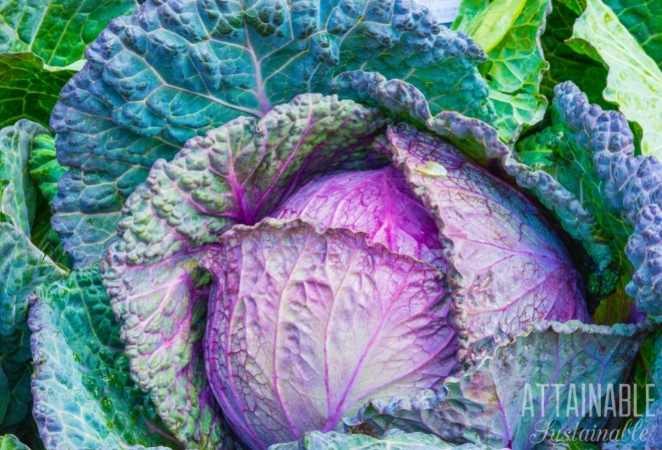
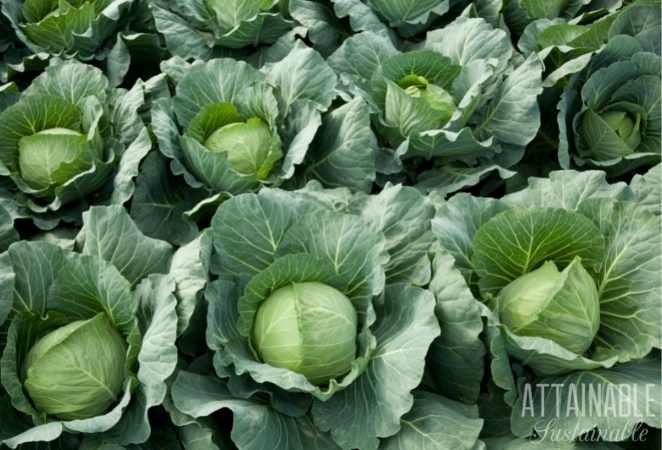
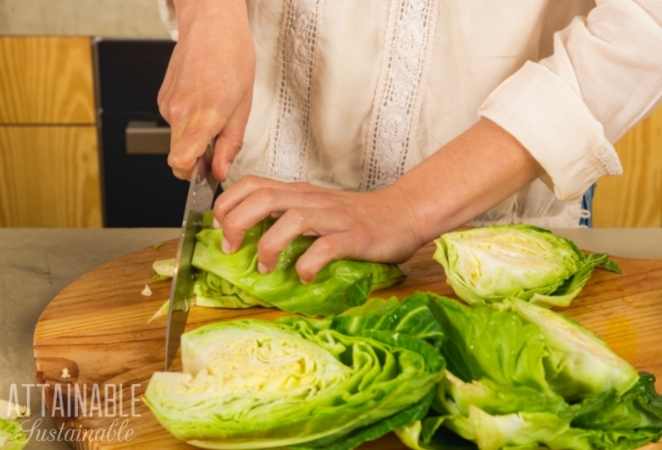
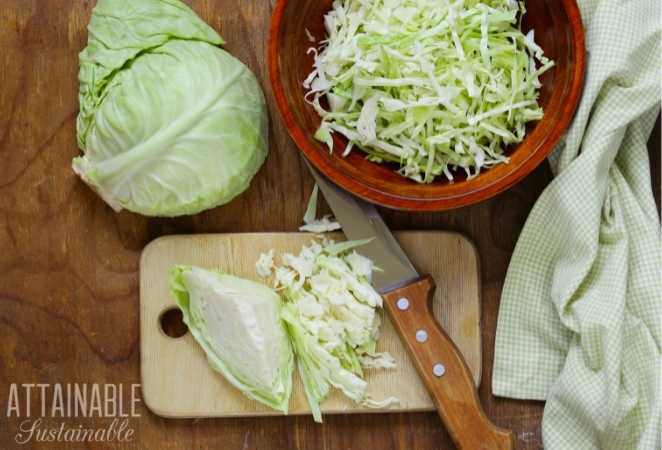
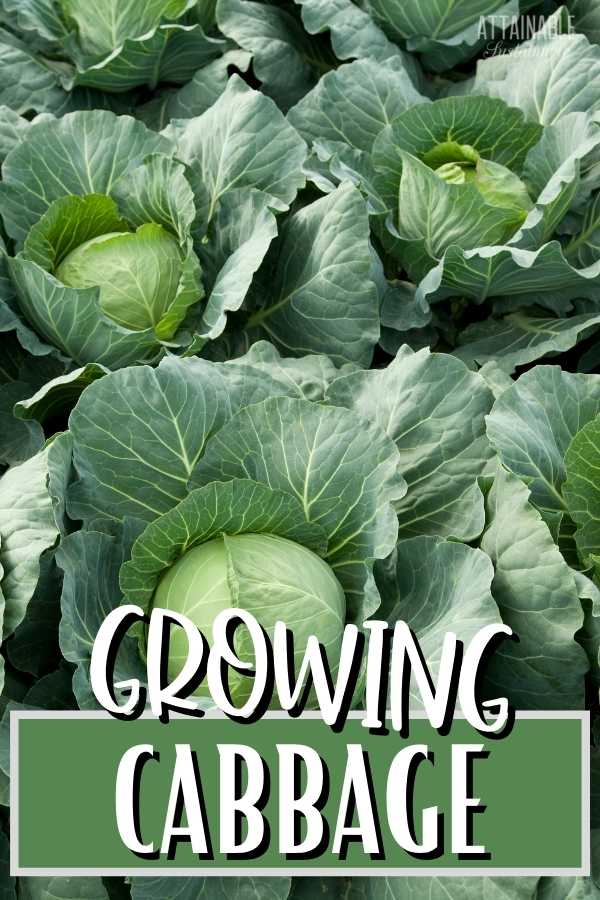





l grew cabbage but the heads turn like a leafy like plant instead of the heads
There are varieties of cabbage that look leafier and less like a head. Bok Choy, savoy, and napa are a few. I wonder if the one you planted is of those types.